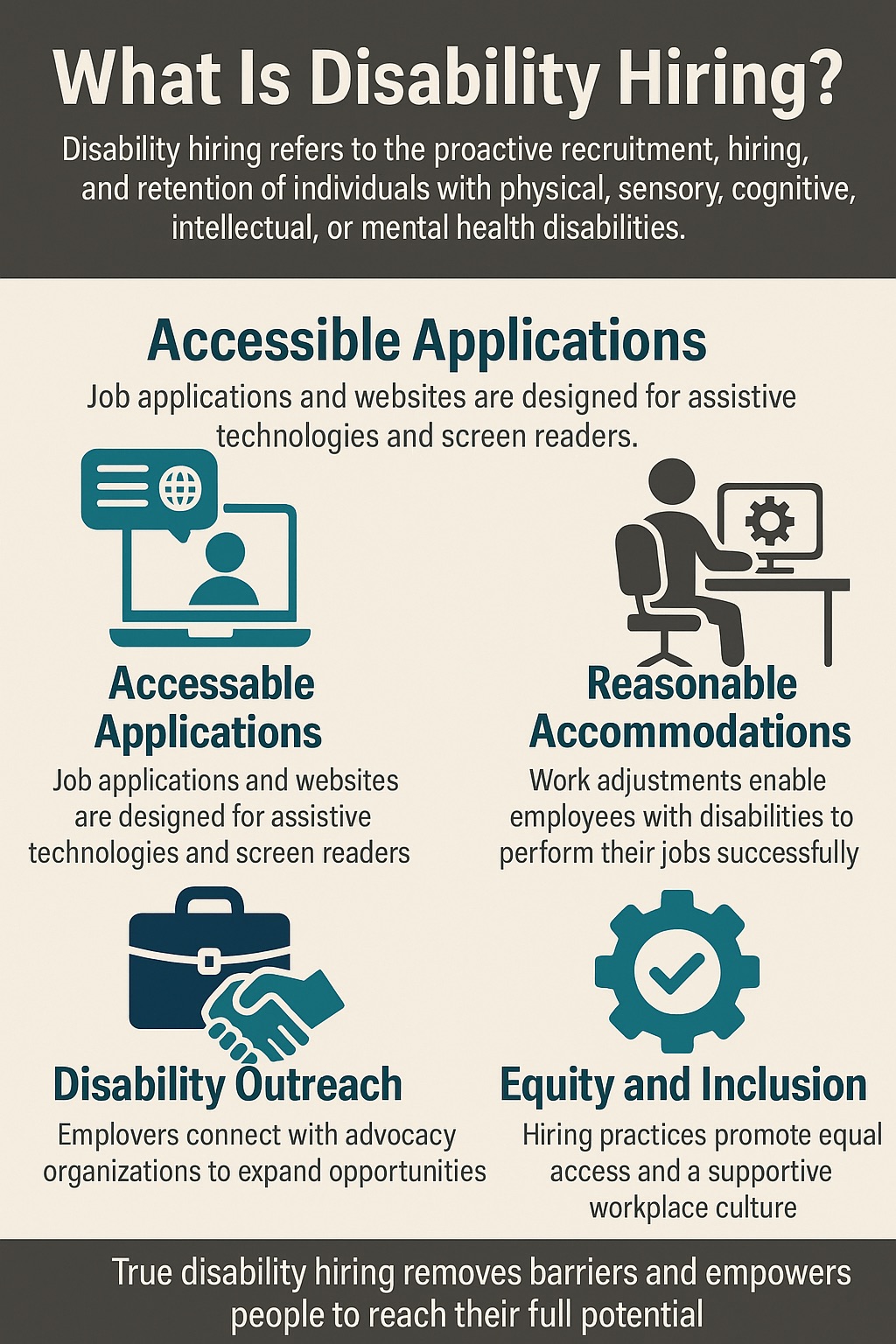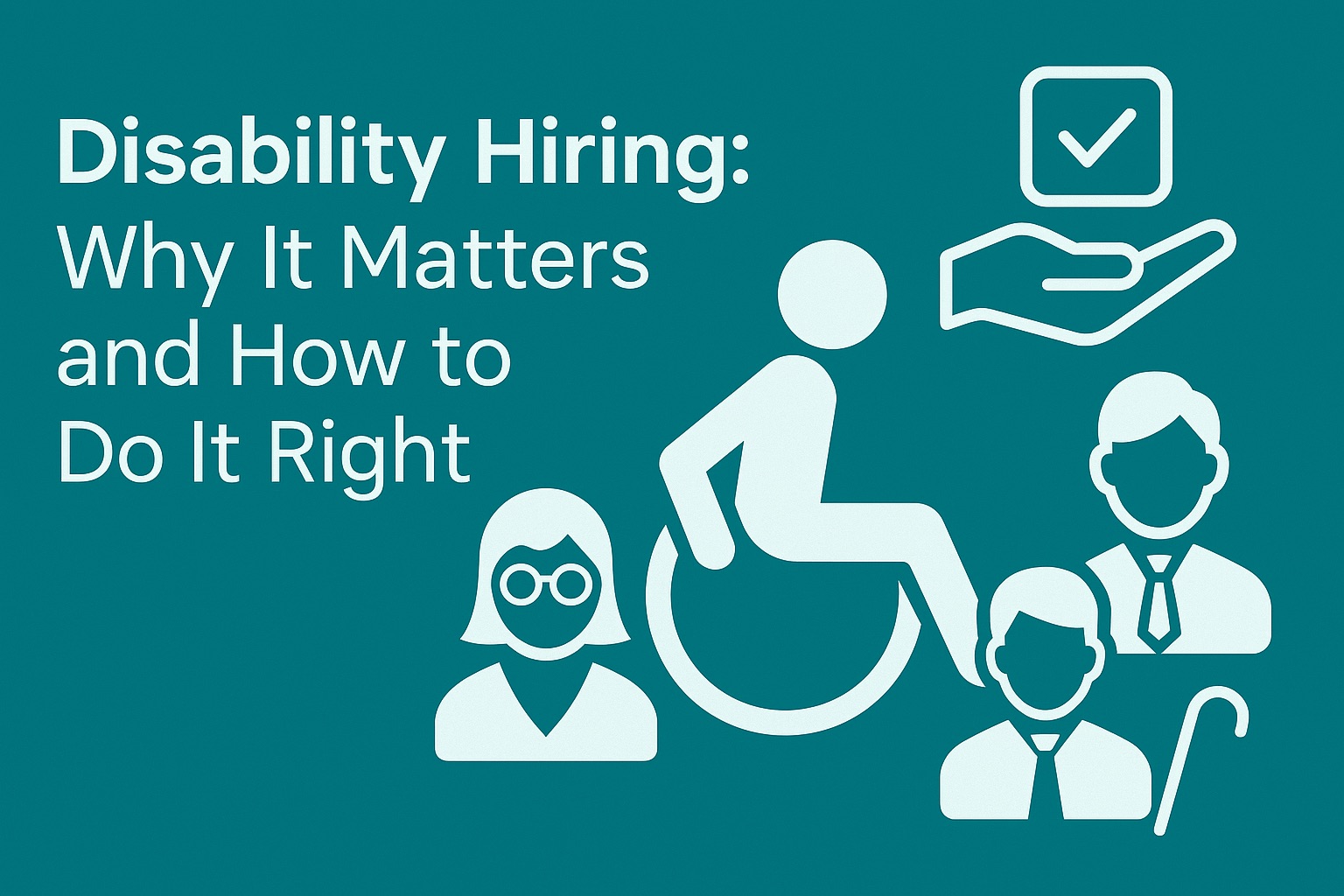Hiring people with disabilities isn’t just a compliance checkbox—it’s a meaningful step toward building a more inclusive, capable, and resilient workforce. Yet, despite progress in awareness and legislation, many businesses still struggle to create pathways for hiring people with disabilities.
From understanding what disability hiring means to learning how to attract, recruit, and support this untapped talent pool, here’s what you need to know.
What Is Disability Hiring?
Disability hiring refers to the proactive recruitment, hiring, and retention of individuals with physical, sensory, cognitive, intellectual, or mental health disabilities. It goes beyond legal compliance—such as meeting requirements under the Americans with Disabilities Act (ADA)—and focuses on creating a workplace that actively supports equity and meaningful inclusion.
At its core, disability hiring is about ensuring that every qualified individual has equal access to apply for, secure, and succeed in a role. That starts with making job applications accessible. Many career sites and applicant tracking systems are not compatible with assistive technologies like screen readers or keyboard navigation. This creates a significant barrier for candidates with visual or motor impairments. To be truly inclusive, companies must design application processes that meet Web Content Accessibility Guidelines (WCAG), allow for plain-language instructions, and offer flexibility for timed assessments.

Once hired, supporting employees with disabilities involves providing reasonable accommodations—adjustments to the work environment that enable them to perform their job effectively. This might include flexible work hours, remote options, ergonomic equipment, screen magnifiers, speech-to-text tools, or quiet spaces for those with sensory sensitivities. Accommodations are not special treatment—they are tools to create a level playing field and are often simple and inexpensive to implement.
Another key aspect of disability hiring is outreach. Many companies want to diversify their workforce but don’t know how to connect with qualified candidates who have disabilities. Partnering with disability advocacy organizations can help bridge this gap. Groups like Easterseals, the National Organization on Disability (NOD), vocational rehabilitation (VR) agencies, and The Arc provide candidate referrals, training resources, and onboarding support. These partnerships help employers tap into an often-overlooked talent pool while also building a culture of inclusion.
True disability hiring is not just about filling quotas—it’s about creating systems that remove barriers and empower people to bring their full potential to work. It’s about designing jobs, processes, and policies that reflect the reality that talent comes in many forms—and disability is not a limitation, but a dimension of human diversity.
Why Disability Hiring Is Important
Hiring people with disabilities isn’t just the right thing to do from a moral or legal standpoint—it’s also a smart business decision. Organizations that embrace disability inclusion often see measurable gains in innovation, employee retention, brand reputation, and overall performance.
To start, people with disabilities frequently bring unique problem-solving skills and adaptability to the workplace. Many have had to navigate physical, societal, or systemic barriers throughout their lives, which naturally sharpens their creativity, resilience, and ability to think outside the box. These qualities translate into fresh perspectives that can fuel innovation within teams and across departments.
Disability hiring also contributes to higher employee retention. Multiple studies have shown that workers with disabilities tend to stay in their roles longer than their non-disabled peers. They bring strong commitment, loyalty, and a desire to prove their value—qualities that can reduce turnover and associated training costs.
Beyond internal benefits, a company’s brand reputation improves when it actively includes people with disabilities. Consumers and job seekers increasingly prefer organizations that align with their values—and inclusion is a growing priority. Publicly demonstrating your commitment to accessibility and diversity can enhance your image in the marketplace, helping to attract top talent and loyal customers alike.
There’s also a clear business case for performance. A 2020 report by Accenture found that companies with inclusive employment practices for people with disabilities were twice as likely to outperform their peers in terms of total shareholder returns. These companies had higher revenue, better profit margins, and stronger net income compared to those with less inclusive practices.
In short, hiring people with disabilities strengthens workplace culture, expands your talent pool, and delivers tangible business outcomes. It’s not about charity—it’s about investing in a workforce that reflects the diversity and strength of the real world.
What Is the Disability Hire Act?
In the United States, disability hiring is reinforced by key federal laws like:
-
The Americans with Disabilities Act (ADA): Prohibits discrimination and ensures reasonable accommodations in the workplace.
-
Section 503 of the Rehabilitation Act: Requires federal contractors to take affirmative action to employ and advance qualified individuals with disabilities.
-
The Workforce Innovation and Opportunity Act (WIOA): Supports job training and career services for job seekers with disabilities.
These laws aim to level the playing field and ensure people with disabilities have equal opportunities in hiring, training, and advancement.
How to Hire More People with Disabilities
Want to open your doors to a more inclusive workforce? Start here:

1. Rethink Job Descriptions
Focus on essential skills and outcomes—not rigid requirements like lifting heavy objects or having a driver’s license, unless they’re truly necessary.
2. Make the Application Process Accessible
Ensure your career site works with screen readers, video content includes captions, and online forms can be navigated using a keyboard.
3. Partner with Disability Organizations
Reach out to groups like Easterseals, National Organization on Disability (NOD), or Vocational Rehabilitation (VR)agencies. They can help with sourcing, support, and guidance.
4. Educate Hiring Managers
Train your team on inclusive interviewing techniques and unconscious bias. Emphasize that accommodations don’t equal lowered standards—they just level the field.
5. Offer Internships or Work-Based Learning
These programs are a low-risk way for both parties to assess fit and build confidence.
6. Highlight Disability Inclusion in Employer Branding
Share stories of employees with disabilities. Make it clear your company supports—and celebrates—diverse abilities.
7. Build an Accommodation Process
Make it easy for candidates and employees to request accommodations confidentially and without fear of judgment.
How to Get a Disability Hire Job
If you’re a job seeker with a disability, here are a few steps to help you connect with inclusive employers:
-
Explore federal programs like the Schedule A Hiring Authority, which expedites hiring for federal jobs.
-
Work with local VR agencies to get job coaching, resume help, and interview prep.
-
Target inclusive employers. Use platforms like AbilityJobs.com, GettingHired.com, or look for the “Disability Confident Employer” designation on LinkedIn.
-
Network intentionally. Join disability support groups, attend job fairs for people with disabilities, and use social media to follow diversity-forward companies.
Easy Jobs for Disabled Adults
While “easy” varies depending on individual abilities, here are commonly accessible roles that offer flexibility, low physical demand, or remote work options:
-
Customer service representative (remote or phone-based)
-
Data entry clerk
-
Copywriter or editor
-
Call center agent
-
Virtual assistant
-
Tutor or online instructor
-
IT help desk support
-
Social media manager
-
Administrative assistant
The key is to find roles that match strengths—not limitations—and to communicate any needed accommodations upfront.
Federal Government Jobs for People with Disabilities
The U.S. federal government is one of the largest inclusive employers for people with disabilities. Agencies use Schedule A hiring to streamline the process for qualified candidates. Applicants must provide documentation of a disability and proof of job readiness.
Start your search at:
Tip: Look for roles labeled “Schedule A” or “Disability Hiring Pathway” and work with a Selective Placement Program Coordinator (SPPC) to assist with the application.
Final Thoughts
Disability hiring isn’t just about legal compliance—it’s about tapping into a deep well of talent, perspective, and resilience. Whether you’re a company looking to diversify your workforce or an individual exploring your next opportunity, creating space for disability inclusion makes your team stronger.
It’s time to move beyond awareness—and into action.
